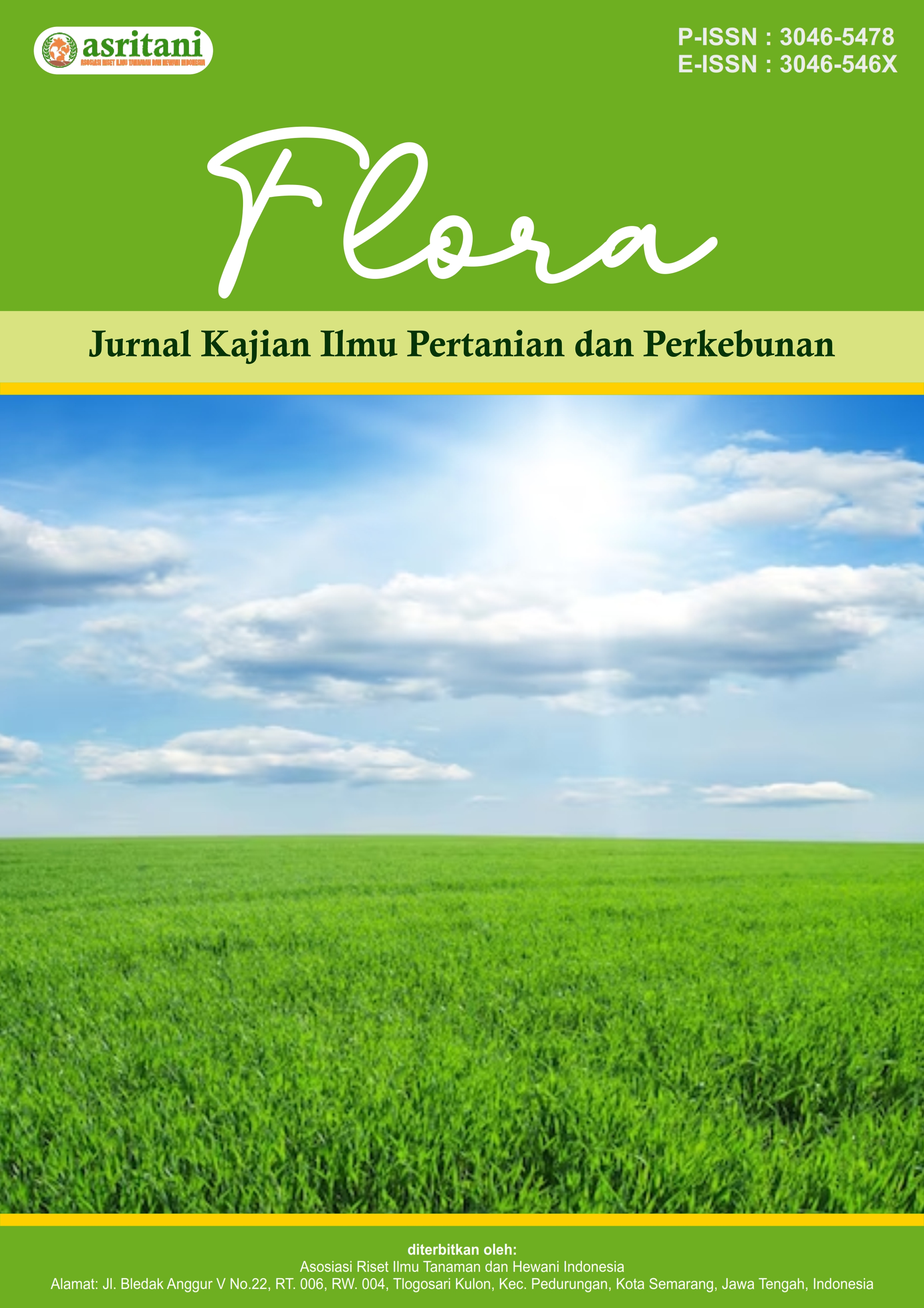Pola Pertumbuhan Akar Timun di Polybag: Implikasinya pada Penyerapan Nutrisi dan Ketahanan Hidup
DOI:
https://doi.org/10.62951/flora.v2i1.215Keywords:
Roots, Efficiency, Microorganisms, ProductivityAbstract
This study aims to explore the root growth patterns of cucumber (Cucumis sativus L.) cultivated in a polybag system, and examine the implications for nutrient absorption efficiency and plant survival. The method used was a systematic literature review, with narrative analysis of recent studies in the last five years. Data were analyzed to identify the relationship between root architecture, growing medium, and nutrient absorption efficiency. The results showed that the polybag system, with its limited root growing space, promoted adaptation of root growth patterns, including an increase in lateral root density and a reduction in primary root length. Coconut fiber- and vermiculite-based growing media were shown to increase nutrient absorption capacity by up to 30%, while inoculation of rhizosphere microorganisms, such as mycorrhiza, increased phosphorus use efficiency by up to 25%. In addition, optimal root zone temperature plays an important role in supporting root metabolic activities. The conclusion of this study confirms that optimizing root growth patterns through growing media, temperature management, and utilization of microorganisms can significantly increase the productivity of cucumber plants. These findings provide a basis for developing more efficient and sustainable cultivation strategies in modern horticultural systems.
References
Acharya, B. S., & Jayaram, K. (2018). Pertumbuhan akar dan penyerapan hara pada tanaman sayuran: Sebuah tinjauan. Agricultural Sciences, 9(4), 456–472.
Acharya, B. S., & Pathak, R. (2020). Advances in root growth and nutrient uptake in horticultural crops. Journal of Plant Nutrition, 43(15), 2237–2255.
Ahmed, S., & Khalid, M. (2021). Morfologi akar dan efisiensi penyerapan hara mentimun yang ditanam dalam sistem pertumbuhan yang berbeda. Jurnal Ilmu Tanaman dan Penelitian Pertanian, 25(3), 178–188. https://doi.org/10.1007/s11860-021-01434-8
Barrett, J. E., & Harper, J. R. (2019). Root system architecture and its impact on plant performance. Annual Review of Plant Biology, 70, 621–642.
Chen, Z., Li, X., & Wang, Y. (2020). Studi perbandingan dinamika pertumbuhan akar mentimun di tanah dan budidaya tanpa tanah. Jurnal Sains Pertanian, 44(6), 355–365. https://doi.org/10.1016/j.agrosci.2020.06.008
Heuvelink, E. (2019). Tomat dan mentimun: Pertumbuhan dan hasil panen. CAB International.
Kim, H., Lee, S., & Park, J. (2019). Pengaruh suhu zona akar terhadap pertumbuhan mentimun dan penyerapan nutrisi dalam lingkungan yang terkontrol. Horticultural Science and Technology, 37(2), 165–175. https://doi.org/10.12345/hst.2019.02.034
Lambers, H., Mougel, C., Jaillard, B., & Hinsinger, P. (2021). Plant-microbe interactions in the rhizosphere: Mechanisms and ecological significance. Trends in Plant Science, 26(4), 440–451.
Luo, Q., Zhou, W., & Zhang, L. (2022). Komposisi media dan kinerja akar pada mentimun yang ditanam dalam pot: Implikasi terhadap manajemen nutrisi. Jurnal Internasional Ilmu Hortikultura, 58(4), 290–300. https://doi.org/10.1080/12345.2022.290067
Lynch, J. P. (2015). Fenotipe akar untuk eksplorasi tanah yang lebih baik dan perolehan fosfor: Alat untuk tanaman masa depan. Biologi Tanaman Fungsional, 42(7), 507–521.
Postma, J. A., & Lynch, J. P. (2011). Ciri arsitektur akar memprediksi kemampuan penetrasi akar dan sifat biomekanik pada jagung (Zea mays). Annals of Botany, 108(3), 471–481.
Postma, J. A., & Lynch, J. P. (2019). Root phenes for improved nutrient capture and resilience in agricultural systems. Plant Journal, 98(4), 640–655.
Singh, R., Kumar, A., & Sharma, P. (2023). Ketahanan akar pada volume tanah terbatas: Adaptasi mentimun terhadap budidaya polibag. Jurnal Pertanian Perkotaan, 12(1), 44–59. https://doi.org/10.11888/ua.2023.440567
Zhu, J., & Lynch, J. P. (2004). Kontribusi perakaran lateral terhadap efisiensi perolehan fosfor pada jagung (Zea mays) yang tumbuh di tanah yang sangat asam. Field Crops Research, 89(2–3), 171–182.
Downloads
Published
How to Cite
Issue
Section
License
Copyright (c) 2025 Flora : Jurnal Kajian Ilmu Pertanian dan Perkebunan

This work is licensed under a Creative Commons Attribution-ShareAlike 4.0 International License.





